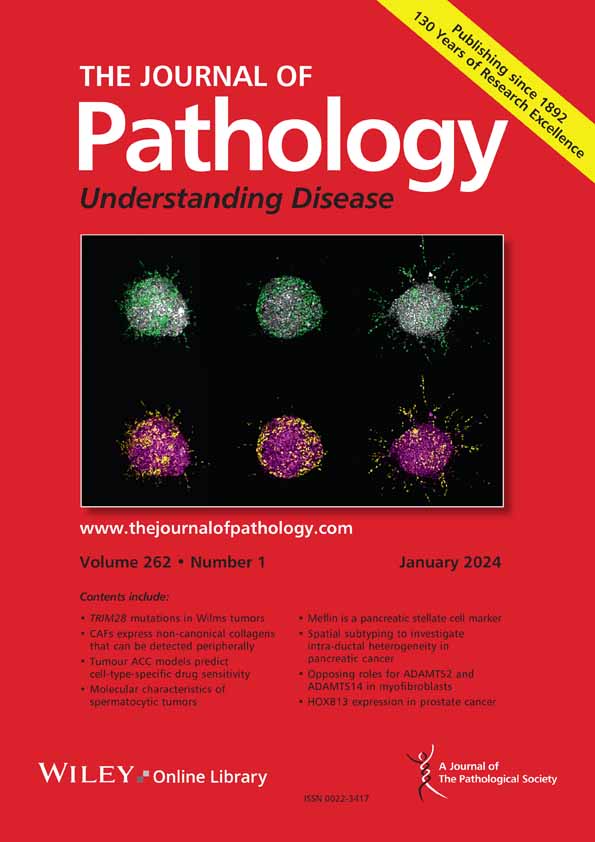Distinct spatial N-glycan profiles reveal glioblastoma-specific signatures.
Aaron O Angerstein, Lyndsay E A Young, Thatchawan Thanasupawat, Jerry Vriend, Grace Grimsley, Xueqing Lun, Donna L Senger, Namita Sinha, Jason Beiko, Marshall Pitz, Sabine Hombach-Klonisch, Richard R Drake, Thomas Klonisch
求助PDF
{"title":"Distinct spatial N-glycan profiles reveal glioblastoma-specific signatures.","authors":"Aaron O Angerstein, Lyndsay E A Young, Thatchawan Thanasupawat, Jerry Vriend, Grace Grimsley, Xueqing Lun, Donna L Senger, Namita Sinha, Jason Beiko, Marshall Pitz, Sabine Hombach-Klonisch, Richard R Drake, Thomas Klonisch","doi":"10.1002/path.6401","DOIUrl":null,"url":null,"abstract":"<p><p>This study explored the complex interactions between glycosylation patterns, tumour biology, and therapeutic responses to temozolomide (TMZ) in human malignant glioma, specifically CNS WHO grade 3 oligodendroglioma (ODG) and glioblastoma (GB). Using spatial imaging of N-glycans in formalin-fixed paraffin-embedded (FFPE) tissue sections via MALDI-MSI, we analysed the N-glycome in primary and recurrent GB tissues and orthotopic xenografts of patient-derived brain tumour-initiating cells (BTIC) sensitive or resistant to TMZ. We identified unique N-glycosylation profiles, with nontumor brain (NTB) and ODG showing higher levels of bisecting and tri-antennary structures, while GB exhibited more tetra-antennary and sialylated N-glycans. Distinctive sialylation patterns were observed, with specific α2,6 and α2,3 isomeric linkages significantly altered in GB. Moreover, comparative analysis of primary and recurrent GB tissues revealed elevated high mannose N-glycans in primary GB and fucosylated bi- and tri-antennary N-glycans in recurrent GB tissues. Next, in the orthotopic xenografts of TMZ-sensitive and TMZ-resistant patient brain tumour initiating cells (BTIC), we identified potential N-glycan markers for TMZ treatment response and resistance. Finally, we found significantly altered expression of genes involved in N-glycan biosynthesis in malignant glioma, highlighting the crucial role of N-glycans in glioma and therapy resistance. This study lays the foundation for developing glycosylation-based diagnostic biomarkers and targeted therapies, potentially improving clinical outcomes for GB patients. © 2025 The Pathological Society of Great Britain and Ireland.</p>","PeriodicalId":232,"journal":{"name":"The Journal of Pathology","volume":" ","pages":""},"PeriodicalIF":5.6000,"publicationDate":"2025-02-19","publicationTypes":"Journal Article","fieldsOfStudy":null,"isOpenAccess":false,"openAccessPdf":"","citationCount":"0","resultStr":null,"platform":"Semanticscholar","paperid":null,"PeriodicalName":"The Journal of Pathology","FirstCategoryId":"3","ListUrlMain":"https://doi.org/10.1002/path.6401","RegionNum":2,"RegionCategory":"医学","ArticlePicture":[],"TitleCN":null,"AbstractTextCN":null,"PMCID":null,"EPubDate":"","PubModel":"","JCR":"Q1","JCRName":"ONCOLOGY","Score":null,"Total":0}
引用次数: 0
引用
批量引用
Abstract
This study explored the complex interactions between glycosylation patterns, tumour biology, and therapeutic responses to temozolomide (TMZ) in human malignant glioma, specifically CNS WHO grade 3 oligodendroglioma (ODG) and glioblastoma (GB). Using spatial imaging of N-glycans in formalin-fixed paraffin-embedded (FFPE) tissue sections via MALDI-MSI, we analysed the N-glycome in primary and recurrent GB tissues and orthotopic xenografts of patient-derived brain tumour-initiating cells (BTIC) sensitive or resistant to TMZ. We identified unique N-glycosylation profiles, with nontumor brain (NTB) and ODG showing higher levels of bisecting and tri-antennary structures, while GB exhibited more tetra-antennary and sialylated N-glycans. Distinctive sialylation patterns were observed, with specific α2,6 and α2,3 isomeric linkages significantly altered in GB. Moreover, comparative analysis of primary and recurrent GB tissues revealed elevated high mannose N-glycans in primary GB and fucosylated bi- and tri-antennary N-glycans in recurrent GB tissues. Next, in the orthotopic xenografts of TMZ-sensitive and TMZ-resistant patient brain tumour initiating cells (BTIC), we identified potential N-glycan markers for TMZ treatment response and resistance. Finally, we found significantly altered expression of genes involved in N-glycan biosynthesis in malignant glioma, highlighting the crucial role of N-glycans in glioma and therapy resistance. This study lays the foundation for developing glycosylation-based diagnostic biomarkers and targeted therapies, potentially improving clinical outcomes for GB patients. © 2025 The Pathological Society of Great Britain and Ireland.


